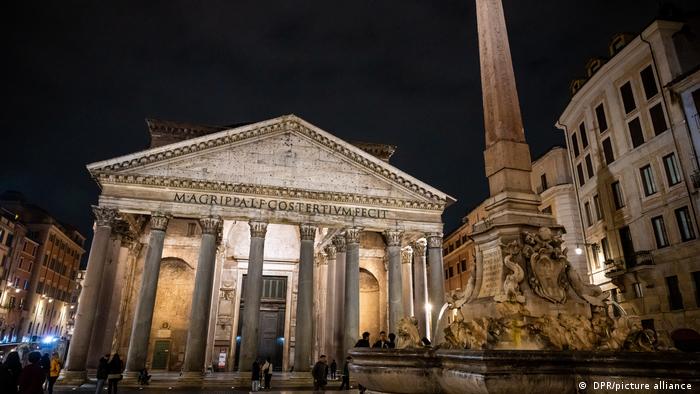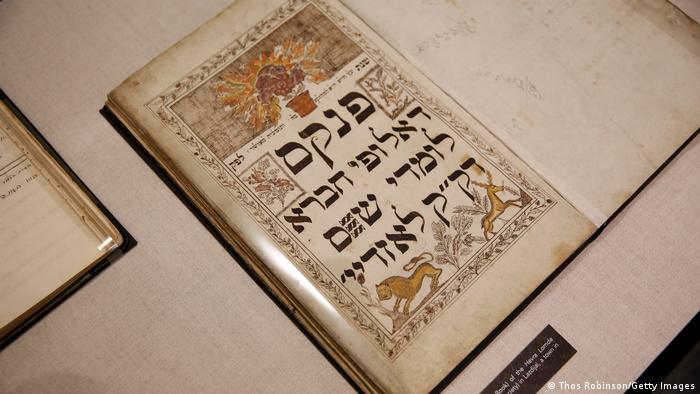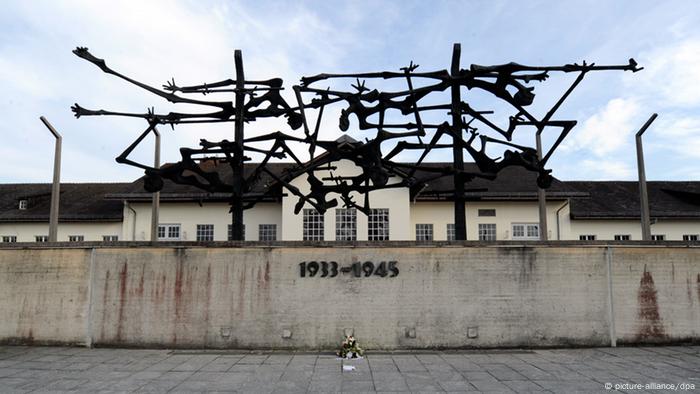It’s possible that I shall make an ass of myself. But in that case one can always get out of it with a little dialectic. I have, of course, so worded my proposition as to be right either way (K.Marx, Letter to F.Engels on the Indian Mutiny)
Saturday, February 05, 2022
Peru: President Castillo sacks PM accused of domestic violence
President Pedro Castillo has sacked newly appointed Prime Minister Hector Valer Pinto just three days after appointing him. He was reported for domestic violence by his wife and daughter in 2016.
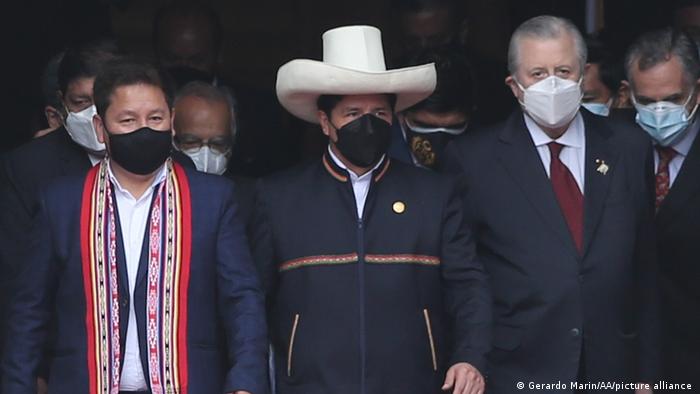
This is the fourth shake-up of Castillo's ministers.
Peru's President Pedro Castillo sacked Prime Minister Hector Valer Pinto three days after appointing him, after revelations that he was accused of domestic violence.
"I have decided to recompose the cabinet," he said in a television address, where he did not mention Pinto by name.
This is Castillo's third cabinet reshuffle. He said he would reconstitute the cabinet, after leaders in Congress declined to hold a vote of confidence on the Cabinet named Tuesday. The opposition and some other cabinet members were opposed to Pinto's presence in the government.
Charges of domestic violence
Pinto came under pressure after newspapers said his wife and daughter had reported him twice for domestic violence in 2016. He has denied being an "abuser," and said he was never convicted.
A judge had issued a protective order for his wife.
He had said he would stay in his job unless Congress passed a vote of no-confidence. Castillo's new cabinet still needs to be confirmed through a congressional vote. The prime minister position in Peru is the chief adviser to the president and also presides and helps appoint the rest of the cabinet.
Unstable government
The new cabinet will be Castillo's fourth since taking power in 2021.
"Not only was Castillo unprepared for national political office, he also did not have a political or social base to count on for support, nor was he able to bring in capable advisers and experts in the various sectors any president needs to govern," Cynthia Sanborn, political science professor at Peru's Universidad del Pacifico told AP news agency.
Castillo was a schoolteacher and an underdog in Peru's last elections. Experts had warned of his political inexperience being detrimental to his position of power.
Many have also criticized Peru's political system, in which no party holds a majority and it is difficult to push through new programs or make changes.
tg/aw (AFP, AP, Reuters)
More than 60% of people who took part in a survey said they liked working from home. Many employees have not been to the office during the coronavirus pandemic.

More than half of the participants found working from home helped them combine family and work lives
Three out of five people who work from home in Germany said they were largely happy with their set-up, a survey carried out by Forsa on behalf of the insurer KKH revealed on Saturday.
According to the survey, 61% of employees who have already done their office job from home or another location have had mostly positive experiences.
However, around one-fifth of the 1,002 people who took part in the survey described their experiences with remote work as mainly negative.
Combining work and family
Around 70% of those who participated said it helped them combine family and work lives, due to not being in the office.
Regarding overall well-being, the survey was less conclusive, with 20% saying that working from home had a positive effect, while just as many reported their health had deteriorated.
The main health issues in the feedback were back pain and muscle tension.
Indeed, according to KKH insurance data from 2021, more people are taking time off due to ill-health than in the past. The health insurance company attributes 24% of all days off to musculoskeletal disorders. In previous years, it was at around 22 to 23%.
Mental health
Often people work remotely without a suitable desk or office chair, according to KKH economic psychologist Antje Judick. Sitting for long periods in an unhealthy position in front of the computer leads to more neck, shoulder and back complaints, while "mental stress can also trigger tension and pain," Judick said.
Some two-thirds of those working from home who reported being affected by mental illness are women, the survey showed.
"Mostly it is always the women who take care of the children and the household in addition to their job," said Judick. "This was especially stressful during the lockdown periods when daycare centers and schools were closed," she added.
Singles suffer from lack of interaction
According to Forsa, working singles also suffer more in the home office than people who live with a partner, citing the lack of social interactions that come with being in the office.
From March 2020, as the coronavirus spread through Europe, an abundance of employers instructed workers to work from home, where many have remained throughout the two years of the pandemic.
Written by: John Silk, Edited by Farah Bahgat
The cement and concrete industry is one of the most neglected in the fight against climate change. It's responsible for about 8% of global carbon dioxide emissions, more than double those from flying or shipping.
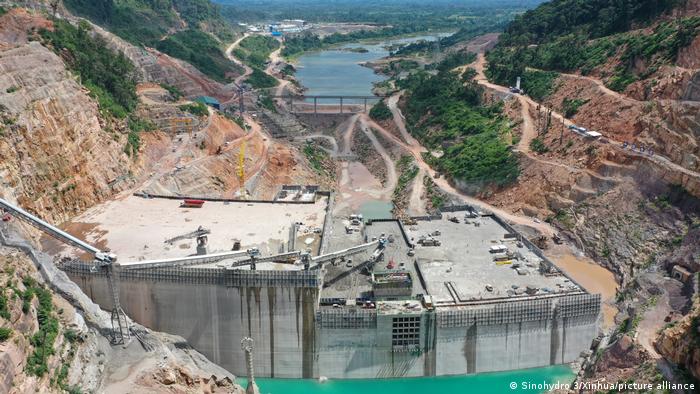
Concrete use is expected to rise as countries across the world build more infrastructure
It is the most widely used substance on the planet after water, an essential ingredient in modern cities and — depending on where you live — supports everything from the roof over your head to the dams and bridges that make up essential infrastructure.
But concrete, a wonder material that has revolutionized construction and raised living standards across thaw me world, is one of the most powerful drivers of global warming.
The cement industry is responsible for about 8% of global carbon dioxide emissions, more than double those from flying or shipping. If it were a country its yearly pollution would only be topped by the US and China.
Yet more than 4 billion tons of cement are produced each year to build houses, motorways, flood defenses and more. Its use is expected to keep rising as people in poorer countries move to cities and demand standards of housing and infrastructure that have long been enjoyed in richer parts of the world. China, which makes over half the world's cement, poured more in just the few years from 2011 to 2013 than the US did in the entire 20th century.
"The fundamental challenge is that [concrete] is incredibly carbon intensive, it is a definite problem, yet we probably will continue to use more of it," said Johanna Lehne, a specialist in decarbonizing industrial processes at climate think tank E3G in Brussels.
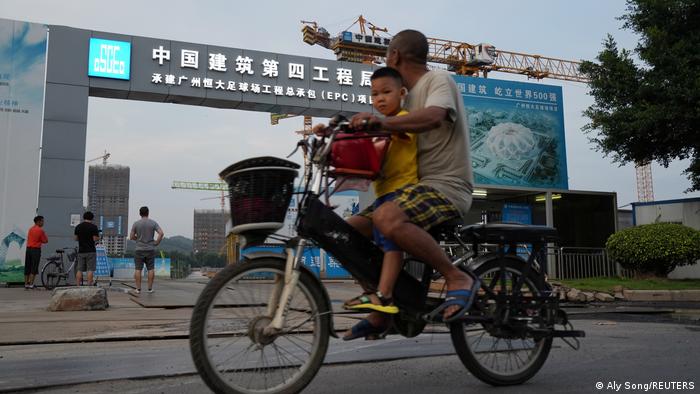
A concrete-powered construction boom has helped drive China's rapid growth
Why climate-friendly concrete doesn't exist
Concrete has a simple recipe. It is made by mixing cheap rocks known as aggregates — typically fine sand and chunky gravel — with cement and water. When combined, these last two react to form a binder that glues the components tightly together.
Producing the cement is what makes concrete so dirty. Manufacturers burn fossil fuels to heat rotating kilns to temperatures above 1400 degrees Celsius as part of a process that turns limestones and clays into what's known as clinker — the main component in cement. The chemical reaction to break down the limestone is what releases the bulk of the CO2.
But because that process is an inherent part of cement production, there is no obvious technology to eliminate the emissions from concrete. Unlike the power or transport sectors, for instance, cement presents "a fundamental technical challenge," said Lehne. The concrete industry lacks the equivalent of wind turbines or electric cars.
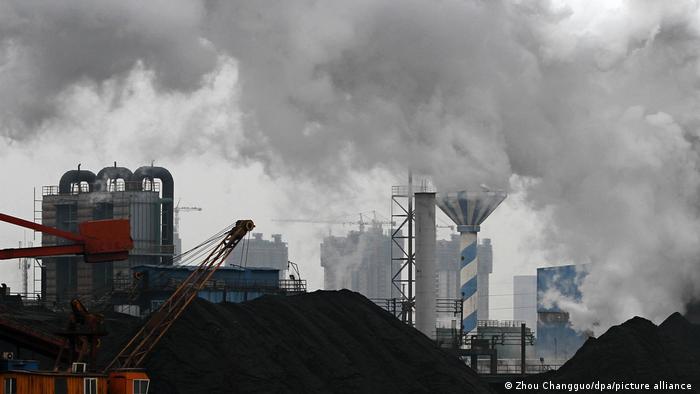
Cement kilns are typically heated by burning coal
How to clean the cement industry
In October 2021 the Global Cement and Concrete Association, a lobby group whose members represent 80% of cement production outside of China and include several Chinese manufacturers, released a roadmap to fully decarbonize the industry by 2050.
About 40% of the planned savings broadly involve changes to produce cement and concrete more efficiently. That includes heating kilns without using fossil fuels — perhaps from burning rubbish in waste incineration plants — or replacing some of the clinker with waste from steel and coal plants.
Almost one-quarter of the emissions cuts come from designing more efficient buildings and extending their lifetimes — processes over which the industry has little control. This could mean architects and engineers retrofitting old buildings instead of knocking them down and designing new ones to last longer.
The final — and most speculative — third of the savings come from capturing carbon dioxide after it has been released.
Although the technology to capture carbon dioxide exists, it is expensive and untested at scale, and its development in the cement industry is still in the early stages. That means a cornerstone of the industry's plans rests on a technology that isn't yet ready to fix the problem.
"In the next 10 years we have to make that technology mature — and prove the industrial scalability and the commercial scalability of the technology," said Thomas Guillot, CEO of GCCA, which has urged policymakers and investors to coordinate with the industry to develop the necessary infrastructure. "It's not something that would be easy."
By 2030 the GCCA — which has called for help from local governments and other actors in the supply change — wants carbon capture technology applied at industrial scale in 10 cement plants. The first of these is being built by German concrete producer Heidelberg Cement in Norway, where it hopes to suck in half the CO2 emitted at the plant and permanently store it. The GCCA roadmap lists 29 carbon capture projects under various stages of development at cement plants across the world.
While analysts have praised the roadmap for its realistic 2050 targets, they have also criticized its vague short-term commitments to cut emissions. The GCCA members have not yet made detailed commitments explaining how they will cut pollution this decade. That will come later in the year, said Guillot. "What we want to do is to really walk the talk and to transform commitments into actions, global visions into local requirements."
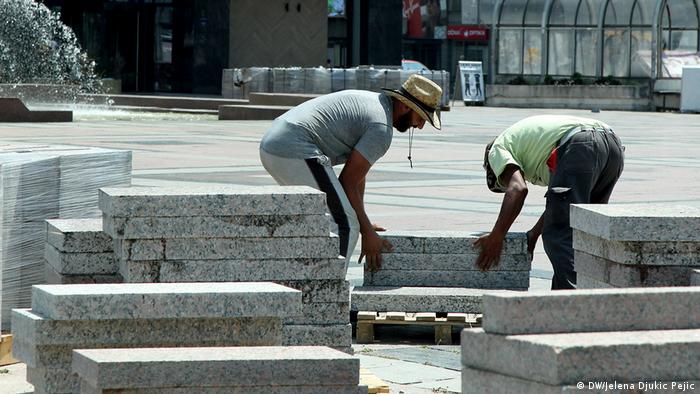
Building waste could be recycled and injected with CO2 for use as an aggregate in concrete
Future solutions
There are smaller-scale solutions that show early signs of promise.
In Sweden, a pilot study by energy company Vattenfall has shown cement can technically be made from electricity without using fossil fuels. Other researchers are exploring how CO2 could be injected into crushed concrete and reused as an aggregate. In France, one company has successfully converted cement bypass dust into lightweight aggregates using CO2 captured on-site.
The cost of capturing carbon is still a large barrier for cement manufacturers, said Maarten van Roon, chief commercial officer at Carbon8 Systems, the company behind the technology. By turning waste into something usable instead of paying for landfill, "we help remove a cost from the supply chain and that, in turn, helps us justify an expense for putting the innovation on site."
Concrete's carbon footprint could also be lowered by using sustainably sourced timber in construction. But replacing concrete with timber at large scale would put enormous pressure on the planet's beleaguered forests.
"Most people think concrete has a huge impact on the environment, and they are right," said Jorge de Brito, a civil engineering professor at the University of Lisbon in Portugal, who has published a study assessing green concrete alternatives. "But concrete has that impact because it's the most used material."
Edited by: Tamsin Walker
Watch video04:21 Switzerland: Building a cement-free future
In the Middle East, culture around recreational drugs is changing
Smoking cannabis on social media and sharing jokes about getting stoned are leading to more openness about recreational drug use in a region where intoxication of any kind is usually frowned upon.
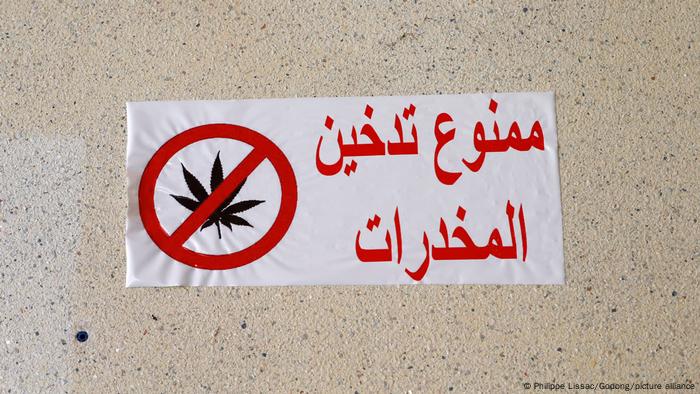
A sign in a Moroccan cafe reads "no drug smoking here"
The grainy video on Facebook shows Abdel-Fattah el-Sissi , Egypt's authoritarian leader, in what appears to be a hall filled with soldiers.
El-Sissi, a military officer who has been running the country since deposing its elected president in 2013, takes the microphone, says a few words, then starts to laugh. He can't stop and begins to snort and gasp.
"El-Sissi is a stoner," says a mocking caption under the 2017 Facebook post, punctuated with laughing emoticons.
This kind of joke is just one of thousands found on Arabic-language pages on social media that specialize in what is known as "stoner humor." Some have millions of followers.
Livestreaming drug use
"Stoner humor" is just one example of how a more casual attitude toward smoking cannabis is becoming increasingly popular in some parts of the Middle East.
Recently there have also been a number of cases in Gulf States where social media users have filmed themselves smoking cannabis. Some were arrested by local police.
Last summer, Dubai-based influencer and model Omar Borkan al-Gala was expelled from the emirate for allegedly smoking cannabis during a live stream on his Instagram account, where he has 1.3 million followers.
Senior Dubai police officers justified his expulsion, saying that there was a strong correlation between celebrities who promoted the use of illicit drugs and teenagers under pressure to try them.
In 2021, Qatar police blocked 75 online profiles and websites for selling or promoting drugs. In 2019, they only blocked 15.
In the past, Saudi police have said people who share stoner jokes were responsible for the disintegration of decent society.
Historical precedent
Despite the outrage from law enforcement, locals in the Middle East have always used drugs.
"It is true that people there historically condemned intoxication, in whatever form it took," Maziyar Ghiabi, a lecturer in medical humanities at the University of Exeter who focuses on drug policy, pointed out. "But that doesn't mean that it didn't exist."
Cannabis has been part of Middle Eastern culture for ages. In the 12th century, some orders of Sufis, who practice a more mystical form of Islam, smoked cannabis as part of religious rituals.
However, until recently, few locals have been overt about their recreational use of illegal drugs.
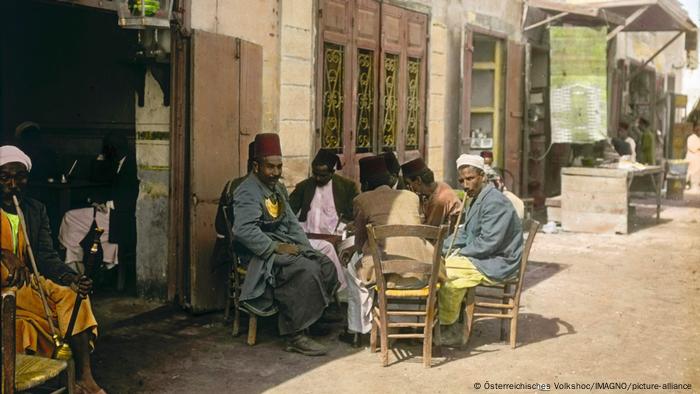
Egyptian men smoke waterpipes with hashish, in around 1910
"Young people's attitudes towards things like hashish [cannabis resin] are definitely changing," said Mahmoud, a 32-year-old Syrian who lives in Germany and didn't wish to give his full name because of the subject matter.
Back in his native Damascus, Mahmoud said he and his friends smoked hashish, or cannabis resin, and took amphetamine pills — known by the brand name Captagon — for fun. The pills contain a mix of amphetamines and are often referred to as the poor man's cocaine.
But Mahmoud says only his closest friends knew about his recreational drug use. He believes that now younger people from the region, especially those from its urban centers, are more open about such things.
Asked when attitudes began to change, Mahmoud smiled and answered: "Since the Internet."
International influence
A study called "Drugs Behind the Veil of Islam: A View of Saudi Youth," published last October 2021 in the scientific journal Crime, Law and Social Change, came to similar conclusions.
Researchers did in-depth interviews with 18 Saudi university students and concluded that young Saudis are becoming more interested in, and open about, using drugs such as cannabis recreationally, especially online.
"The Hekmat Mohashish account posts so many funny videos and stories about hashish smokers," one of the interviewees said, referring to a popular Facebook page that posted information and jokes about recreational drugs and had more than 1 million followers. "They are so funny that people even don't think smoking hashish is haram [not allowed].”

Morocco is the world's largest producer of cannabis, even though the drug is illegal there
The study also came up with other reasons for a more neutral attitude toward illicit drugs in Saudi Arabia — including more interactions with foreigners and international culture, how religious (or not) people are and the recent loosening of rules on social interaction.
Hidden numbers
"With social media, everything is more open now," Elie Aaraj, director of the Beirut-based Middle East and North Africa Harm Reduction Association, or MENAHRA, told DW. "A younger generation knows more about drugs and how to use them."
It is impossible to know whether these changes in attitude online translate to increased drug use in real life though. Primarily this is because there are few reliable statistics on the topic.
"Data from the Middle East is scarce, and therefore we cannot say anything about any increasing trend in drug use for the region," a spokesperson from the United Nations Office on Drugs and Crime, or UNODC, told DW. The organization compiles an annual report on illicit drug use around the world.
In its 2021 assessment of the region, MENAHRA confirmed that fact, noting that the various crises around the region make it difficult to come up with exact numbers on drug use or abuse.
While each country has different patterns of drug use depending on what substance is most readily available, the advisory organization believes that cannabis is still the most popular drug overall in the Middle East.
The experts concluded that increasing openness about its use could be seen as positive in some ways.
A more realistic approach to drug use might result in a more "plausible, coherent public policy that minimizes the risks of drug use," Exeter University researcher Ghiabi argued.
"We need more than just repressive rules [on drug use] because these are not enough to deal with this situation," Aaraj concluded.
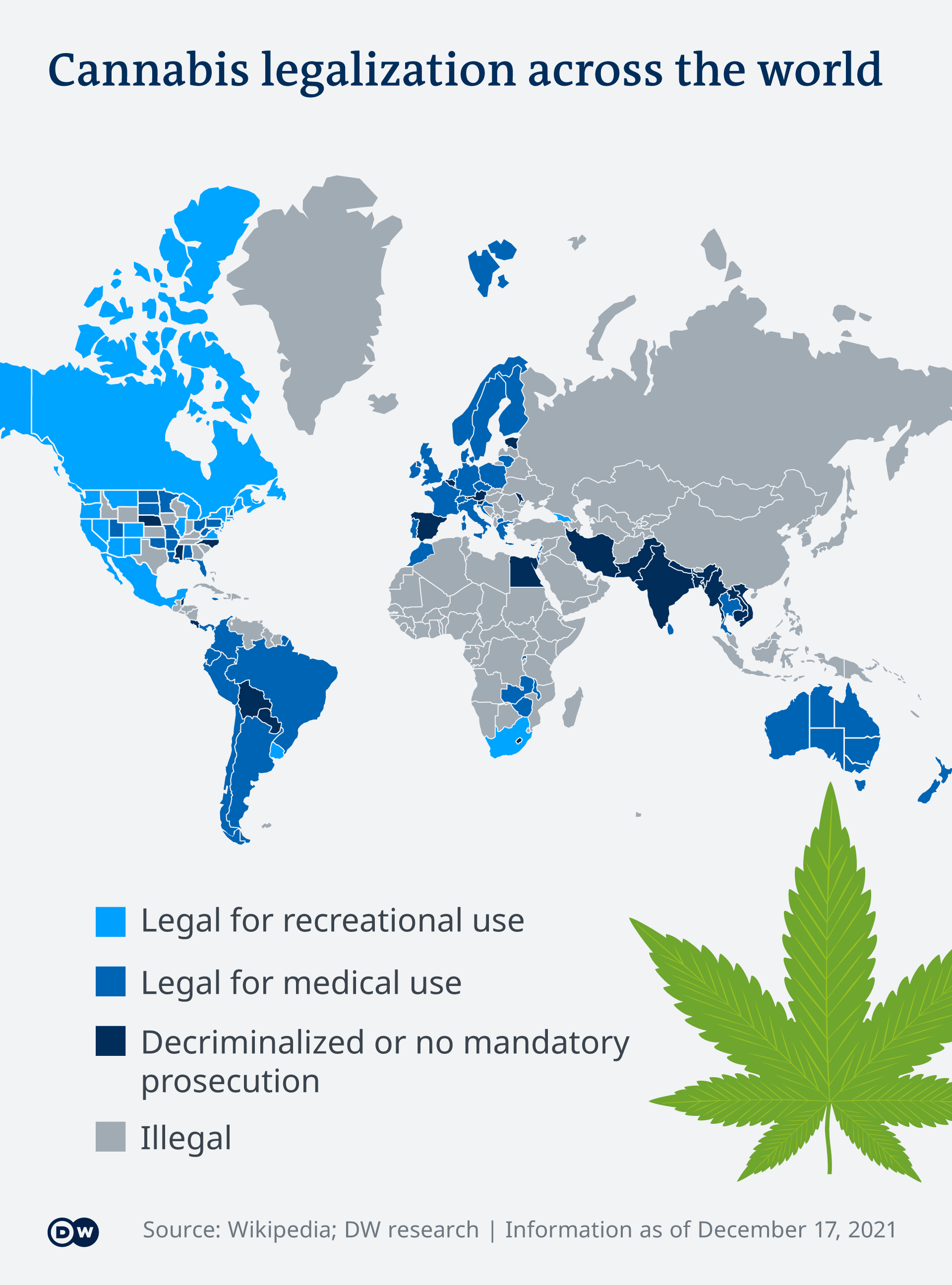
Edited by: Jon Shelton
DW RECOMMENDS
Fahad Shah, the editor of news portal Kashmir Walla, has been accused of inciting violence and "glorifying terrorism" as Indian officials continue their media clampdown.
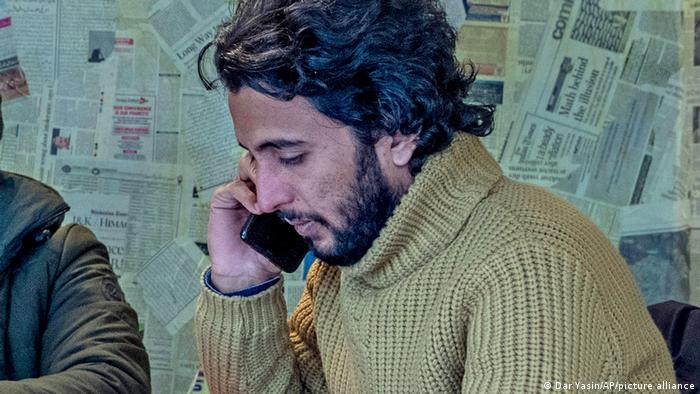
Fahad Shah has been accused of 'glorifying terrorism and spreading fake news'
Police in Indian-controlled Kashmir have arrested a prominent journalist accused of publishing "anti-national content" as part of a widening clampdown on media in the disputed region.
On Saturday, police tweeted that Fahad Shah was wanted in three cases of "glorifying terrorism, spreading fake news and inciting general public for creating L&O (law and order) situations."
Shah serves as the editor of news portal Kashmir Walla. He was questioned by authorities in southern Pulwama town on Friday and subsequently arrested.
Police said Shah was identified among users of Facebook and other online portals who had published content that had a "criminal intention" to spark fear and could "provoke the public to disturb law and order."
Watch video04:22 Is the media crackdown in Kashmir escalating?
Gunfight report linked to the arrest
Shah's arrest is believed to be connected to a gunfight inside a civilian house between Kashmiri rebels and Indian troops in Pulwama on January 30. Police had said a rebel commander was killed in the hostilities along with a Pakistani and another local militant. The fourth person killed was the house owner's teenage son. The authorities described the youth as a "hybrid" militant, a term police began use for alleged militants with no police record and who operate as civilians.
The Kashmir Walla website carried a series of reports on the gunfight presenting both sides. One video report quoted family members of the slain teenager refuting the police. Another piece of footage quoted the boy's sister which contradicted an earlier statement from the family.
In recent years Shah has come under increasing scrutiny over his reporting. He had already been questioned by police officers several times relating to his media work, long before Friday's arrest.
Shah's detention illustrated the "utter disregard" authorities have in the region "for press freedom and the fundamental right of journalists to report freely and safely," said the head of the Committee to Protect Journalists' (CPJ) Asia program, Steven Butler.
Dozens of journalists in Indian-controlled Kashmir have regularly been summoned by police and questioned for their work since 2019, when New Delhi revoked the territory's partial autonomy, bringing it under direct rule.
jsi/dj (AP, AFP)
Rights activists and family members of victims say the Indian army in Kashmir is using a legal loophole to get away with murder.

Human rights advocates say Indian troops can operate with 'impunity' in Kashmir
On a summer morning in 2020, 25-year-old Abrar Chouhan rose early to play with his son before leaving his village in Indian-administered Kashmir to work as a seasonal laborer in an apple orchard.
He knew that he wouldn't see his family for some time as he headed off to work with his brother-in-law.
"I told him not to leave me alone, but he wanted to earn money to complete construction of our house and to get our son into a good school," his wife, Shireen Akhter, told DW.
Little did she know, her husband would never return.
He was one of three men killed by the Indian army on July 17, 2020, in a remote cabin located on a hilltop covered in apple orchards outside the town of Shopian.
Following the incident, the Indian army released a statement claiming that it had killed three "Pakistani militants" who fired on them, and recovered pistols and other ammunition from them.
Based on pictures of their bodies, the men were identified as Chouhan, his 16-year-old brother-in-law, Abrar Khan, and another 21-year-old man named Imtiyaz Hussain.
Laborers killed to allegedly collect a bounty
The killings triggered protests and an investigation into why these men, who had no affiliation with Pakistani militants, were shot by Indian Army soldiers.
In December 2020, Jammu and Kashmir police determined that the killings were part of a scheme in which reward money and promotions are given out to army officers in exchange for targeting militants.

Shireen Akhter says her husband was killed by Indian army soldiers for a bounty
In some cases, civilians are falsely branded militants and killed to reap a reward from the Indian army.
In the orchard killings, two civilian "informers" and an Indian army officer are accused of staging the entire incident to collect a bounty equivalent to $27,000 (€23,000).
Police said army officer Captain Bhoopendra Singh "furnished false information to mislead senior officers into granting the reward, in furtherance of a criminal conspiracy."
Legal loophole complicates prosecution
In Kashmir, when local authorities need to investigate Indian army soldiers accused of human rights violations, they must first seek permission from New Delhi under the Armed Forces Special Powers Act (AFSPA).
For decades, the Indian military has been fighting Pakistan-backed insurgents in Kashmir. Islamabad says it provides only diplomatic support to Kashmiri insurgents.
According to an Indian army statement to DW, "Pakistan continues to be obsessed with Kashmir," and engages in a "vigorous proxy war in the Union Territory."
"Therefore, there is a requirement to conduct counter-terrorism operations to secure lives of the citizens," the statement read.
The Indian military also says the act is necessary to allow soldiers to respond to threats without fear of prosecution.
Critics argue that the AFSPA gives Indian armed forces wide powers to shoot to kill, carry out arrests on flimsy pretexts and conduct warrantless searches.
In the Shopian case, the army invoked the AFSPA to have the accused officer and two other army personnel involved stand trial by court martial.
"Initially, we had hope for justice. But, when the case was transferred to a military court, we realized that it will just be another number on a long list of killings in fabricated encounters by the Indian Army in Kashmir. There won’t be any justice," said Shireen Akhter.
Indian human rights activist Vrinda Grover told DW that the AFSPA has allowed the Indian military "unbridled power" in Kashmir for three decades.
"Indian soldiers have raped, tortured and killed people in Kashmir for in fake encounters without fear of being held accountable," she said.
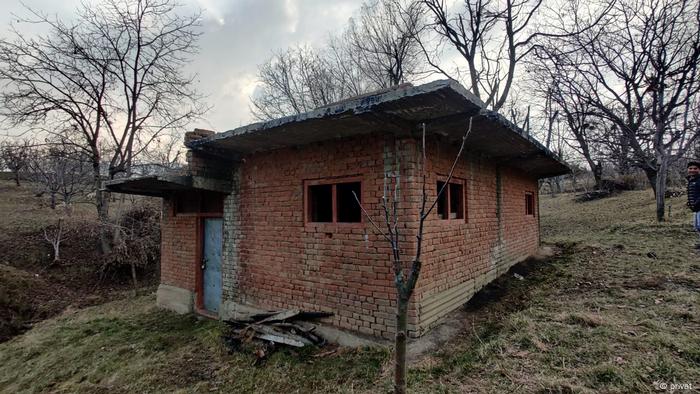
Abrar Chouhan, his brother-in-law, and another man were shot dead in this cabin outside the town of Shopian
Indian army granted 'impunity' in Kashmir
Abdul Rashid Khan, 45, said his father and four other civilians were killed by the Indian army in a "fake encounter" 22 years ago.
The incident took place in southern Kashmir, and eight people were killed in protests that followed.
In 2007, public prosecutors indicted five army officers for killing the protesters. However, using the AFSPA, the army was able to bring the case to court-martial and the charges were subsequently dismissed.
"In a court-martial, the judge, jury and executor are the military, and the proceedings don't meet fair trial processes," Grover said, adding that the AFSPA, combined with court-martial proceedings, allows the military "absolute impunity" to violate human rights and is a continuing failure of the Indian justice system.
"These special laws for armed forces consolidate and entrench this impunity, making accountability impossible for egregious human rights abuses," Grover said.
Military says AFSPA is needed
Retired Indian Army General Ata Hasnain told DW that the act provides protection for soldiers operating in a hostile environment such as Kashmir, where mistakes can happen during operations.
For example, in February 2011, the army killed a young man in a case of mistaken identity.
"He was asked to stop at night, but he ran and got shot. He was innocent, but he flouted the rules of night curfew. Should the soldiers who shot him be prosecuted? Certainly not. They played by rules, he did not. Protection under AFSPA caters for such situations. Otherwise, soldiers will get prosecuted left, right and center," Hasnain said.
In a statement, the Indian army said it had "established a robust mechanism to ensure that all allegations of human rights violations are investigated" and the culprits, "if any, are punished."
The army statement also said there had been "a substantial decrease in the number of allegations of human rights violations against the army in the past few years."
Regarding the Shopian case, the statement said that the "Indian army has been proactive in investigations" and has taken "actions based on evidence, as has been the norm for all allegations and reported incidents in the past."
"In this case, the court-martial of the accused is presently underway, and due process of law will be followed to ensure justice," the statement said.
Lieutenant General DP Pandey, who commands the Indian army's Srinagar-based corps, recently told media that the AFSPA needs to be in force while the army is engaged in counterterrorism operations.
"I am sure the government will look at the revocation of AFSPA at a suitable time when the security situation improves," Pandey said.
Edited by: Wesley Rahn
DW RECOMMENDS
Why is India-administered Kashmir facing a power shortage?
Kashmir's subzero temperatures in winter and a dearth of electricity are a painful mixture for locals. With a vast capacity to produce hydropower, why is so little electricity available?
How will the Taliban takeover impact militancy in Kashmir?
India-administered Kashmir is reportedly seeing a surge in foreign militants. Analysts warn that increasing disaffection among young Kashmiris in the disputed region could have serious consequences.
India: At least 12 killed in stampede at religious shrine
Authorities say more than a dozen people were injured and subsequently hospitalized. An investigation has been launched into the cause of the stampede.
In 1941, Jewish intellectuals forced to work in the Nazi-controlled Vilnius archives risked their lives to hide documents from them. These have now been digitized and can be viewed online.
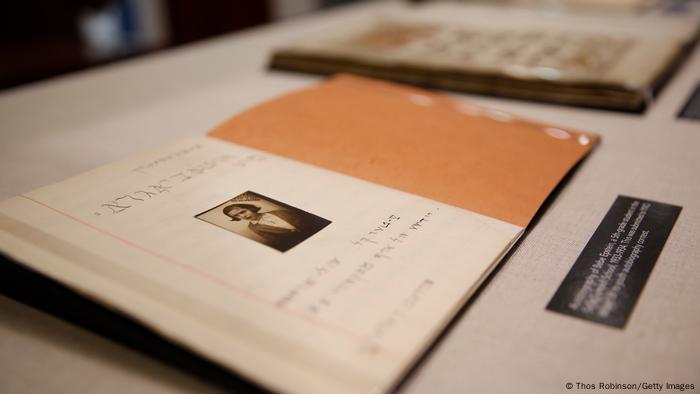
'The Autobiography of Beba Epstein'
In 1925, prominent European intellectuals from the Jewish community, including Sigmund Freud and Albert Einstein, helped establish the Yiddish Scientific Institute (Yidisher Visnshaftlekher Institut, YIVO) in Berlin and Wilno, Poland (now Vilnius in Lithuania). Its task was to collect empirical evidence on modern-day Jewish life.
There was a specific reason for this.
"Everybody had been studying the Talmud since the Middle Ages. The Kabbalah of the Torah," Jonathan Brent, CEO and executive director of the New York-based YIVO Institute of Jewish Research told DW. "But nobody knew what was the actual day-to-day process whereby Jews survived, made their way in the world, cared for their children. What were their actual traditions? What were their songs? What were their relations with their neighbors and their non-Jewish neighbors?"
The same year that YIVO was founded, Max Weinreich, the then-head of YIVO's Wilno (also known as Vilna) branch sent "zamlers" — Yiddish for 'collectors' — around the world to collect information and material from Jewish communities.
He also published advertisements asking people to send posters, letters, political statements, and books as materials for the study on modern Jewish life. YIVO CEO Jonathan Brent explained that Weinreich's call "inflamed the imagination of Jewish people."
"They were excited about this idea. It's not like discovering the faith of a Holy Roman Empire or something that happened in 1492. It was self-discovery…The idea of the YIVO Institute was that this process of self-discovery would equip people to enter into the modern world and build a modern Jewish identity," he added.
Over the next few years, YIVO evolved into "the largest collection of material in the world on East European Jewish life," according to its website.
Nazi takeover
YIVO's success, however, was short-lived. The Nazis had occupied Poland in 1939 and entered Vilnius in 1941. Nazi troops, under Alfred Rosenberg, an NSDAP ideologue and the Third Reich's minister for the eastern occupied territories, seized YIVO's collections. The idea was to destroy part of the material and send some of it to Frankfurt to serve as fodder for the antisemitic ideology that was being churned out by the Institute for Research on the Jewish Question (in German, Institut zur Erforschung der Judenfrage).
Because the Nazis were not well-versed with Jewish culture and local languages, they needed people to sort through YIVO's extensive collections. So, they employed around 32 forced laborers — consisting of mostly Jewish intellectuals that included Yiddish poets Shmerke Kaczerginski and Avrom Sutzkever, and former YIVO co-director Zelig Kalmanovitch — to sift through the archives.
Making away with the loot
When the Nazies occupied Vilnius, they forced the Jews into ghettos and intellectual Jewish slave laborers were roped in for the sorting project inside the YIVO building. At some point, the members of the group decided they didn't want to give the Nazis everything. Many doubts circled their minds: "They could get bombed by the allies. What if the Nazis burned everything at the end of the war?" So, the group decided to hide the documents in the ghettos, Brent explained.
"And in an unbelievable effort, they hid books and papers and all kinds of things on their bodies under their clothes, their pants and their shoes. They walked out of the YIVO building with this material and they walked into the ghetto with it. If any one of them had been detected doing this, they would have been shot on the spot immediately," the expert on Jewish studies continued.
The group succeeded in getting hundreds of thousands of pages of materials and books, and these materials were then hidden in metal canisters underground and a fair amount of it was also given to their non-Jewish friends, namely the Lithuanians and the Poles.
By 1945, much of the material that had been sent to Frankfurt by the Nazis was recovered by a US organization called the Monuments Men and sent to New York, where YIVO's Max Weinreich had fled, and was setting up a new base for the organization. In Vilnius, the documents were dug out after WWII ended in 1945.
"Sutzkever and Kaczerginski had the idea of building a new Jewish museum of Vilnius," Brent explains, adding that by the time, Vilnius had become the capital of Lithuania, which was under Soviet occupation. But soon enough, the Soviets began their own campaign against the Jews.
This time round, there were no remaining Jewish intellectuals to rescue the documents. Instead, it was the Lithuanian librarian, Antanas Ulpis, who preserved the materials in the nooks and crannies of the St.George Church and Carmelite monastery in the Lithuanian capital.
The documents were eventually discovered after the fall of the Soviet Union in 1991.
1.5 million online exhibits
Jonathan Brent became the CEO of the YIVO Institute in New York in 2009. When he visited Lithuania that year, the documents were being stored, as he puts it, "in dark unventilated rooms." Nobody saw or read these materials, which were steadily deteriorating.
Consequently, in 2015, Brent and his colleagues initiated the Edward Blank YIVO Vilna Online Collections project, to digitize the documents, with the additional aim of virtually reuniting YIVO's collections from Lithuania and New York. Some $7 million (€6.2 million) and seven years later, this collection is now online.
Today, YIVO owns over 40,000 rare and unique books and periodicals, and over 1.5 million documents collected from Jews in Eastern Europe.
This includes the "Autobiography of Beba Epstein," which was written in the 1933-1934 school year by Beba Epstein, then aged 11 or 12. Her book, which can be viewed on the YIVO museum's website is described as providing "a look into the life of a vibrant, young girl and an insight into the life of Jewish children in Eastern Europe before the Holocaust."
'NEVER AGAIN': MEMORIALS OF THE HOLOCAUSTDachau Concentration Camp Memorial SiteA large sculpture stands in front of Dachau. Located just outside Munich, it was the first concentration camp opened by the Nazi regime. Just a few weeks after Adolf Hitler came to power, it was used by the paramilitary SS Schutzstaffel to imprison, torture and kill political opponents of the regime. Dachau also served as a prototype and model for the other Nazi camps that followed.
Another notable example is a diary of Theodor Herzl, who convened the first Zionist Congress in Basel, Switzerland in 1897, following the publication of his book "The Jewish State" in 1896. He is one of the founders of the political form of Zionism, which was the movement to establish a Jewish homeland.
"It's the largest collection of pre-war material on Jewish life: Folklore, music, poetry, plays, political organizations, social organizations, cooking, medical records, the organization of the school systems," Brent explained.
The material aims to give its viewers an understanding of how Jewish society was organized — and not without a sprinkling of humor from the olden days. For instance, a 1927 Yiddish hiking manual offers the following advice to its young readers: "Backpacks must be hung up. It's happened before that even a rucksack can go missing and only turn up again in the mouth of a cow!"
The Edward Blank YIVO Vilna Online Collections can be accessed here.
Edited by: Brenda Haas
AUDIOS AND VIDEOS ON THE TOPIC
A catastrophe in court - The Eichmann Trial, 60 years ago
Russia has revoked Deutsche Welle's broadcast license and shut down DW's office in Moscow, after German regulators banned Russian broadcaster RT Deutsch. But the two broadcasters are not the same.

DW is governed by the principle of state neutrality and overseen by an independent council
The Kremlin's decision to shut down DW's operations in Russia seems at first like a tit-for-tat response to the one by German regulators, made a day earlier, to ban Russian broadcaster RT Deutsch from broadcasting in Germany.
But there are significant differences both in the nature of the bans and in the regulations that govern the two foreign broadcasters themselves.
For the former, only RT's live content has been stopped by the German regulator, following its decision not to apply for a broadcast licence. On-demand and online content is unaffected, while RT's correspondents continue to be free to work in Berlin and attend government press conferences. Russia's decision to shut down DW's bureau in Moscow means DW journalists are no longer accredited to work in Russia.
The second point, about how the two broadcasters are governed, can best be summed up in the principle of "state neutrality."
After the experience of the Nazi dictatorship, the German media landscape was designed specifically to prevent those in power from controlling newspapers, broadcasting, and online media.
It is true that both Deutsche Welle and RT, once called Russia Today, are state-funded broadcasters aimed at foreign audiences. But to ensure that Deutsche Welle is allowed work independently and follow journalistic standards, it is not a part of the federal government's press office.
A system of public accountability
Instead, DW is regulated by public law. This means that though its funding comes from the federal budget, the director is accountable only to the DW Broadcasting Council, which also elects him for six years. And even if there is a change of government in Germany, as was the case recently, the director remains in office.
The Broadcasting Council has 17 honorary members: Representatives of civil society, trade unions, churches, and political parties. They see to it that Germany's foreign broadcasting follows DW's mandate, which is "to provide a forum for German and other points of view on essential topics, above all in politics, culture and economics, both in Europe and in other continents, with the aim of promoting understanding and exchange between cultures and peoples."
It is true that RT's English website also states: "RT is an autonomous, non-profit organization that is publicly funded from the budget of the Russian Federation." But the website does not reveal much more about RT: Not about its budget, not about its structure, not about any supervisory bodies.
Independent of government
What seems clear is that there is no principle of state neutrality governing RT, as is required for DW. When Time magazine's Moscow correspondent Simon Shuster visited RT Editor-in-Chief Margareta Simonyan in her office in 2015, he noticed an old-fashioned yellow telephone on her desk. It was her secure line directly to the Kremlin, Simonyan admitted to Shuster, "to discuss secret things." She has been RT's editor-in-chief since its inception in 2005.
In an interview with Russian daily Kommersant in 2012, Simonyan said she saw RT as part of an information war with the Western world, and compared the broadcaster's role to that of the Defense Ministry.
"The Defense Ministry was fighting with Georgia, but we were conducting the information war, and what's more, against the whole Western world," she said. "It's impossible to start making a weapon only when the war has already started! That's why the Defense Ministry isn't fighting anyone at the moment, but it's ready for defense. So are we."
'An instrument of Russian foreign policy'
In 2013, Russian President Vladimir Putin declared that RT "cannot but reflect the official position of the Russian government on events in our country and the rest of the world." Speaking to broadcaster SWR, Stefan Meister, Russia expert at the German Council on Foreign Relations, described RT as a propaganda channel: "It is an instrument of Russian foreign policy with very specific goals. It is a channel controlled by the Foreign Ministry, among others, but also by other state institutions."
There are also differences in the way the foreign media are handled within the country. This is illustrated by the broadcasting ban imposed on RT in Germany by an independent media supervisory authority, the Commission for Licensing and Supervision of the Berlin-Brandenburg Media Authority, which is not a government agency.
The commission justified its broadcasting ban on RT DE by stating that the "required media law license is missing." In other words, the broadcast license had never been applied for, though broadcasting began last December — perhaps because of the state neutrality requirement. Germany's Media Treaty, which regulates the rights of broadcasters in Germany, prohibits — except in exceptional cases — the granting of broadcasting licenses to state bodies in Germany and abroad.
However, RT's parent organization TV Novosti holds a broadcasting license for RT DE in Serbia and considers it sufficient. The German media supervisory authority disagrees, and considers itself responsible because RT's German broadcaster has its headquarters in Berlin.
While DW journalists have now had their accreditations revoked, RT journalists can continue to work in Germany, protected by the principle of press freedom. RT journalists, for example, still regularly sit in on press conferences held by the German government. RT DE can continue to operate its website and can distribute videos — but not stream them live.
In Russia, foreign correspondents must obtain accreditation via an often opaque approval process. In Germany, RT DE can hire journalists and reporters without accreditation, like any other broadcaster.
Meanwhile, the closure of DW's Moscow bureau and the end of DW's broadcasting in Russia was announced by the Russian Foreign Ministry — clearly an indication that the move was politically motivated. Russia said it was reacting to the "unfriendly actions of the Federal Republic of Germany" towards RT DE.
Meanwhile, Russia ranks 150th out of 180 countries in Reporters Without Borders' Press Freedom Index.
While you're here: Every Tuesday, DW editors round up what is happening in German politics and society. You can sign up here for the weekly email newsletter Berlin Briefing.
DW RECOMMENDS
DW's Moscow bureau closes after Russian ban
Russia's move to close Deutsche Welle's bureau in Moscow came as a "huge shock" to the staff. The team stopped their work early on Friday after having their credentials revoked.
Russia's RT channel blocked by German regulators
The German-language version of the Russian state broadcaster can no longer be transmitted in Germany. The timing of the ban comes amid high tensions between Moscow and the West.
YouTube bans RT's German channels — lawmakers and activists react
RT's German YouTube channels have been blocked over alleged COVID-19 misinformation. What does the German government make of the move? And what do other observers think?
YOU MIGHT ALSO LIKE
Max Zahn with Andy Serwer
27 January 2022·
Former president Donald Trump in recent weeks has intensified his public support for COVID-19 vaccines, revealing that he received a booster shot and denouncing politicians who withhold their booster status as "gutless."
The flurry of remarks comes as some public health experts have called for a second version of the Trump administration's vaccine development program, Operation Warp Speed, in response to the emergence of variants like Omicron, Axios reports.
But the push for a new iteration of the vaccine program rekindles debate about the successes and failures of the first initiative.
In a new interview, Gregory Zuckerman — an investigative reporter at the Wall Street Journal and author of "A Shot to Save the World: The Inside Story of the Life-or-Death Race for a COVID-19 Vaccine" — says Operation Warp Speed was "very helpful" to U.S. vaccine development, despite some missteps.
"Like most every other topic in society today, it's sort of black and white," Zuckerman told Yahoo Finance on Nov. 15, before the detection of the Omicron variant. "Either Operation Warp Speed saves everything, and we have to give Donald Trump all the credit, or it was useless."
"I come down somewhere in the middle, meaning that Operation Warp Speed was very helpful," he adds. "There was a lot of money that was given to these companies [and] resources too, little parts that were necessary from all over the country that were brought to the necessary spots.”
Launched in April 2020, Operation Warp Speed drew on $14 billion in federal investment to foster public-private partnerships with pharmaceutical companies.
While Pfizer (PFE) declined government funding for research, it later sold its vaccine to the U.S. for $2 billion. On the other hand, Moderna (MRNA) accepted a total of $4.1 billion in public investment for research and development as well as the acquisition of 200 million doses.
The program helped the U.S. develop a vaccine over a short timespan of 10 months, far less than the 10 years it took to develop a measles vaccine or the 16 years it took to achieve a Hepatitis B vaccine, McKinsey & Company noted in a report last March.
In this episode of Influencers, Andy is joined by ‘A Shot to Save the World’ author, Gregory Zuckerman, as they discuss the development of the COVID-19 vaccines and what the future holds for mRNA technology.
PICKING WINNERS AND LOSERS
But Operation Warp Speed wasn't perfect. The program spent $1.2 billion on the purchase of 300 million doses of the vaccine developed by AstraZeneca and Oxford University. U.S. health authorities still have not approved that vaccine.
Despite the ultimate success of the Moderna vaccine, Operation Warp Speed focused its early investment and attention on the AstraZeneca candidate, Zuckerman said.
"You have to remember that Warp Speed made an early bet on a different vaccine, the AstraZeneca vaccine," Zuckerman says. "It did not give money to Moderna early on when it was desperate for money."
U.S. President Donald Trump delivers remarks at an Operation Warp Speed Vaccine Summit at the White House in Washington, U.S., December 8, 2020. REUTERS/Tom Brenner
To be sure, Trump has opposed some vaccine-related policies — especially mandates. Earlier this month, he urged supporters to "rise up" against possible vaccine mandates for young children, Business Insider reported.
All three Supreme Court justices appointed by Trump joined the majority earlier this month in rejecting the Biden administration's vaccine-or-test rule for businesses with more than 100 employees.
Speaking to Yahoo Finance, Zuckerman noted that Operation Warp Speed contributed to U.S. vaccine development but doesn't account entirely for its success.
"Warp Speed was very helpful," he says. "But you don't want to say it was all due to Warp Speed — the success of these remarkable vaccines."
A resumption in entry approvals for fully vaccinated construction workers from early November drove the rise in non-resident employment during the last quarter. (PHOTO: REUTERS/Edgar Su)
By Low De Wei
(Bloomberg) — Singapore’s non-resident workforce expanded for the first time in two years last quarter, driven by an increase in the construction sector after some border restrictions were eased.
That helped push total employment up by 47,400 in the quarter, the Ministry of Manpower said Friday, as a pick-up in local resident hires also gained pace driven by seasonal hiring in the service and retail sectors and growing demand in areas like IT and financial services.
For December, the seasonally-adjusted overall unemployment rate narrowed to 2.4%, from 2.5% the previous month, the ministry said.
“The unemployment situation continued to improve, and we could expect unemployment rates to decline to pre-Covid levels in the months ahead,” the ministry said in a statement.
The finance and trade hub, which relies on foreign labor across all sectors, has been easing travel restrictions in recent months to alleviate a workforce crunch. Last week, economists at Morgan Stanley warned that labor constraints may further drive inflation, with the ratio of job vacancies to unemployed last year jumping to 2.1, the highest in more than two decades.
Singapore saw a record decline in its population last year, as foreign workers, students and residents left the country after strict border curbs were imposed. The current monthly inflow of foreign workers has more than doubled compared to when entry restrictions were in place last year, Tan Kiat How, minister of state for the Ministry of National Development, said in a speech this week, without providing figures.
A resumption in entry approvals for fully vaccinated construction workers from early November drove the rise in non-resident employment during the last quarter, even as the foreign workforce in other sectors remained relatively flat, the ministry said. Detailed figures will be published in March.
© 2022 Bloomberg L.P.

